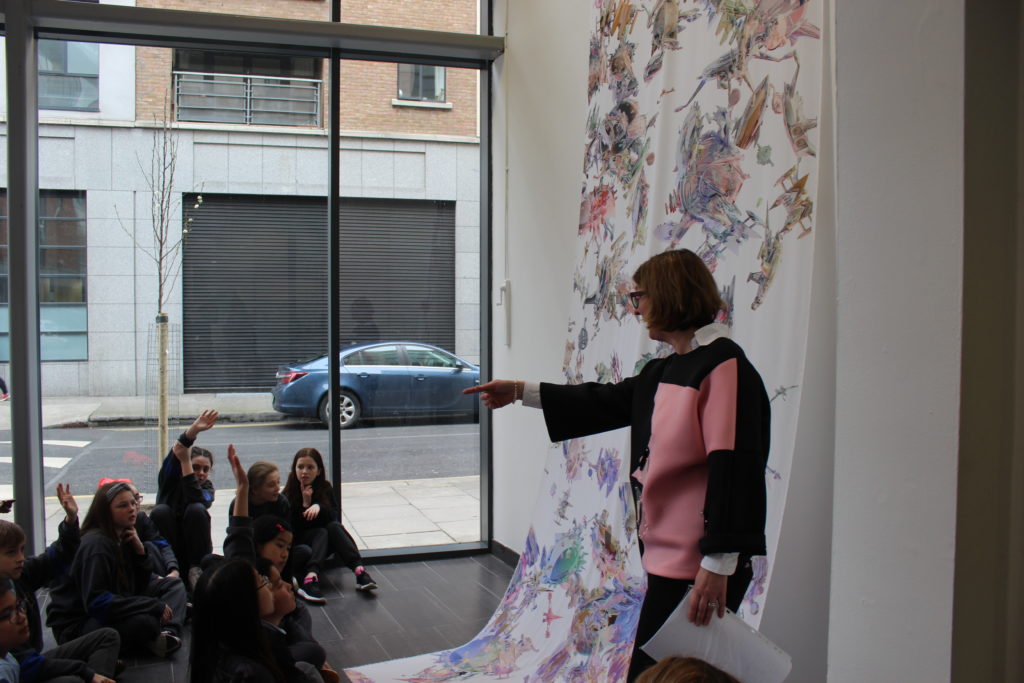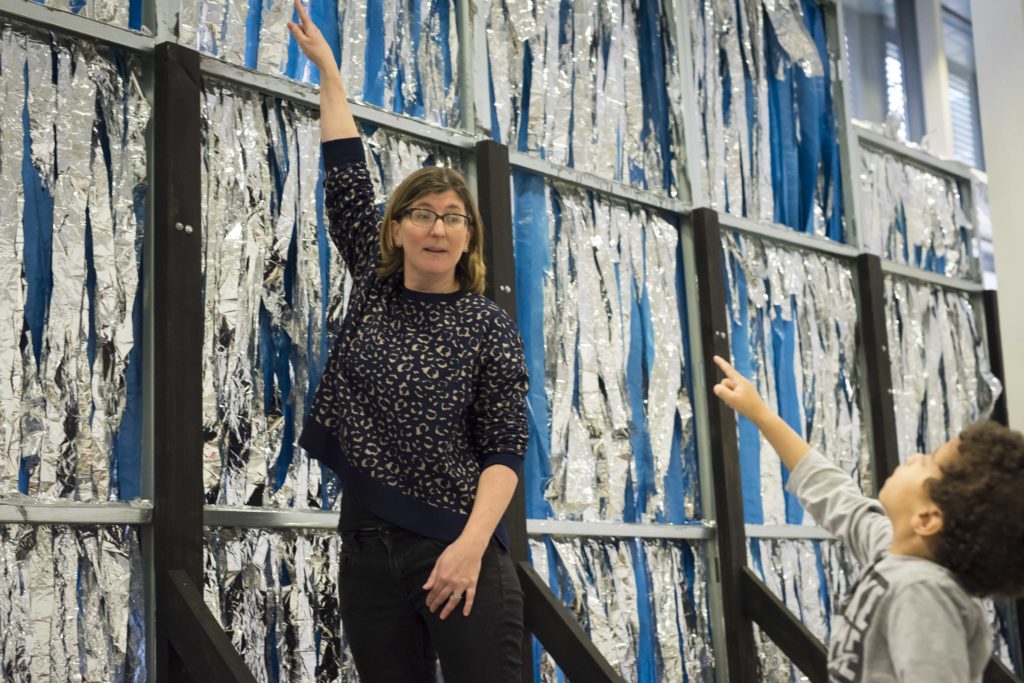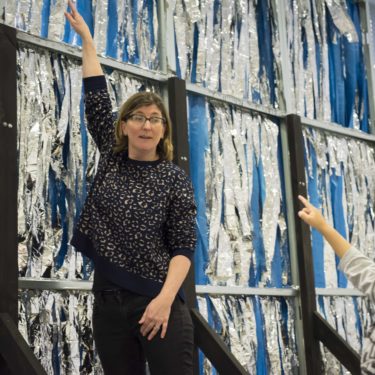When I first heard about VTS, I was initially seduced by the theoretical approach of the method. I was especially struck by the effects of its collective aspect. The fact that the sessions are conducted in groups holds several key benefits. As Abigail Housen highlights, VTS “encourage[s] the group members to think out loud,” enabling the learner to “get exposure to the thinking of peers, which can accelerate shifts in his own thinking.” 1 Through interactions, the group discussion “lead[s] to more observations, more ideas, and usually more accuracy.” 2 Housen and Yenawine thus pointed out how the collective nature of VTS helps to build meaning for the learners: “taking in others’ discoveries stimulates individuals to find more layers of possibility.” 3 I was thus already sensitive to the group characteristic of the methodology from my early research and understood its importance for the learning process of the participants; when I first witnessed a VTS session, however, I began to understand VTS on a deeper level, discovering this aspect of the method in a new light.
I was at the LAB Gallery in Dublin, observing a mixed group of sixth class students (11–12-year olds) from Central Model Senior School, a pioneer school in Dublin testing and implementing VTS with their students for the fifth year.
The class came in overflowing with energy, as you would expect from a group of 20 children leaving school for a gallery visit. They sat in front of an artwork and the facilitator, Liz Coman (Assistant Arts Officer at Dublin City Arts Office, she has initiated VTS in Dublin about six years ago and is the lead person developing it there), asked the students to take a quiet moment to look. The work of art was contemporary, a big fabric sheet hung on the wall, covered with spaceships and other galactic elements. Their joyfully chaotic din suddenly turned into complete silence. That was when the magic started. The group of individuals transformed itself into one entity. Watching this dynamic was absolutely fascinating. In an environment of respect, curiosity, and even encouragement for each other’s ideas, their conversation on the piece evolved fruitfully. One person’s perception seemed to call upon another’s and, building on one another’s speech in this way, soon they were overflowing with new and incredible thoughts about the artwork.

Liz Coman with students from Central Model Senior School, discussing Bassam Al-Sabah, Time, Be Still, digital print on bamboo fabric, 2018. Photo by Julia Moustacchi.
This session was the first time I truly experienced the extent of the benefits VTS can bring to a group. Since then, I have been struck by the sense of group cohesion and the amazing well of ideas and imagination VTS creates. What startled me even more, though, which I had not noticed in my readings on the subject, was how much the group aspect allows for a fusion of ideas. Without the group, there is no possibility of VTS. The power of the method is in putting individual thoughts in touch, forming a collective mind.
Thus, the importance of the group aspect among the benefits engendered by VTS was expanded through my research. My master’s thesis focused on the implementation of VTS in Irish Arts Institutions. I found that one of the main benefits of VTS, building a critical mindset for the learners, was reinforced by the group thinking process. Apart from the fact that VTS enables listening and respecting one another’s opinion, it appeared that hearing other viewpoints activates the possibility of several interpretations. The learners become open to the idea that there is not one but many possible interpretations. When the facilitator links, it also helps the students situate their position among the others. I observed learners acknowledging their differences or assimilation of opinion, saying, “I disagree with” or “I agree with… but… .”
VTS therefore enables a complexity of thinking in the students, who become more open to diverse and even contradictory observations. It is hearing many and various opinions that creates the possibility of this complexity. The students can therefore develop the concept of potentiality, the idea that there can be several explanations and nothing has a fixed meaning. By hearing diverse opinions being validated, they can assimilate the fact that there is no right answer and that what they are doing is giving an interpretation. As the discussion goes on, the students can see that the spectrum of interpretations is infinite. They start using the conditional form to express themselves—“it could be…”—accepting, thanks to their classmates, that they are expressing an opinion which may be one valid idea amongst many others.
One of the teachers that I interviewed thus reported that the method gives her students “the skills to meaningfully debate topics and respond to each other in a very mature and honest way.” 4 Not only does VTS create a platform for debate, it becomes collective, collaborative thinking, which is encouraged by the openness of the practice. A wide variety of comments can be made as there is no right or wrong answer. It “creates a safe space where there is no pressure to contribute, but everyone is enabled to learn about the art by being part of the group discussion.” 5 Much as the mind does, the discussion wanders, goes in one direction, then another, comes back to one element, goes on to another… and it could go on indefinitely. The imagination seems multiplied when brought in common in this safe space. If the facilitators were not timing VTS sessions, they could probably go on for hours.
During my research, I noted the benefits of the group aspect in the practice of VTS, not only for young learners, but also for adults. I collected information on a group of art-knowledgeable adults who regularly attend galleries and museums. They participated in a VTS session at the Hugh Lane Gallery in Dublin for the first time and something quite unusual happened. The facilitator noticed that the group aspect of the methodology made them pass from a strong sense of competition in the beginning of the discussion to a more democratic and respectful space. Being an audience familiar with a museum setting and used to the traditional, vertical transmission of knowledge from the institution’s side, the group was not very keen on listening to one another’s impressions at first. Once they saw that it was not about getting the right answer, however, the group started to appreciate each others’ interventions. They started to actually listen to one another and were then able to build on the expressed ideas. They came in expecting facts coming from arts professionals, but as they went through the process of VTS, they discovered the richness behind this group building of perceptions. Again, they turned from a collection of individual minds to a collective mind overflowing with ideas.

Liz Coman leads a discussion of the work of Amanda Coogan at The Lab in Dublin, Ireland; photo by Louis Haugh.
Indeed, the group aspect of VTS also seems to provide the space for creative thinking. The “safe space” that VTS creates encourages the learners’ imaginations. I was struck by the abundance of ideas from learners of any age. The expression of the participants’ thoughts seems to allow their creative mind to flow, even to the point where the learners themselves can reach a level of engagement they were not expecting.
The Education Officer of the Irish Museum of Modern Art (IMMA), Helen O’Donoghue, experienced this in one VTS session. A member of the adult group participating in the session, who was neither a gallery goer nor familiar with contemporary art, experienced a very strong emotional response to a piece that surprised even himself. Without the group aspect, this level of engagement surely could not have been reached by the participant. Thus, while in my readings, I noticed the importance of working in groups between the age of three to five year-olds, as the children need the “collaboration with one another” at this stage to accomplish tasks students from the next developmental stage can perform on their own, I discovered that the group feature of VTS was necessary at any age. 6 The gathering of minds is the required condition to enable this collective, and therefore richer, thinking.
Through the group aspect of VTS, the methodology seems to enable a “social side of looking at art,” as the Curator of the Lab Gallery and VTS Facilitator Sheena Barrett noticed. A group of people gathers for the sake of looking at and discussing art together and for the effect that comes out of this collaborative thinking. Sheena Barrett also insists on the group aspect as being a major feature of VTS. To her, the core of the VTS experience lies in the fact that it takes place with other people, or as she put it, “you cannot VTS on your own.”
After I finished my research, I took part in VTS sessions myself as a learner. I was struck again by the group aspect, in a way I would not have imagined just by observing VTS facilitations from the outside. As I got engaged in the session, trying to look carefully at the picture to discover what was going on in it, I was surprised by how much my mind was influenced by and fluctuated with others’ comments. During the first silent moment, I have to say, not much was coming to my mind, but when I heard one, two, three ideas from other people, my mind started to jump from one idea to the other, totally ecstatic. My brain was suddenly boiling. I began to see so much it was like a whole new world opened up to me. I felt like I was given the gift of sight for the first time; this amazingly enriching experience would never have been possible on my own.
Questions or comments? Contact us.
Footnotes
- 1 - Abigail Housen, "Eye of the Beholder: Research, Theory and Practice," paper presented at Aesthetic and Art Education: a Transdisciplinary Approach, Lisbon, Portugal, September 1999, 6.
- 2 - Abigail Housen and Philip Yenawine, Understanding the Basics, ed. Madison Brookshire (Bolinas, CA: VTS, 2018), 5.
- 3 - ibid.
- 4 - Marsha Keating (Primary school teacher at Central Model Senior School, using VTS with her students since 2016), interviewed by the author, Dublin, Ireland, 2018.
- 5 - ibid.
- 6 - Lev Vygotsky, "Interaction Between Learning and Development" in Mind in Society: The Development of Higher Psychological Processes (Cambridge, Mass: Harvard, University Press, 1978), 79-91. Vygotsky is referring to Dorothea McCarthy.

